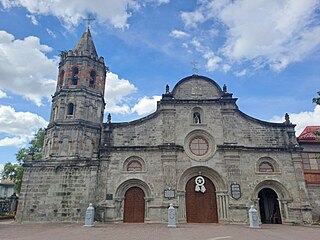
Bulacan, officially the Province of Bulacan, is a province in the Philippines located in the Central Luzon region. Its capital is the city of Malolos. Bulacan was established on August 15, 1578, and part of the Metro Luzon Urban Beltway Super Region.
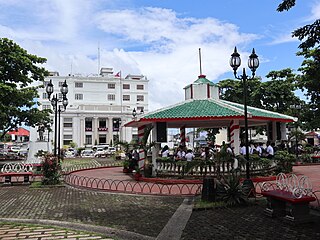
Tabaco, officially the City of Tabaco, is a 4th class component city in the province of Albay, Philippines. According to the 2020 census, it has a population of 140,961 people.

San Miguel Corporation, abbreviated as SMC, is a Philippine multinational conglomerate headquartered in Mandaluyong, Metro Manila. The company is one of the largest and most diversified conglomerates in the Philippines. Originally founded in 1890 as brewery in the Philippines, San Miguel has ventured beyond its core business, with investments in various sectors such as food and drink, finance, infrastructure, oil and energy, transportation, and real estate.

San Miguel is a primarily middle-class residential area of the City of Manila, and is one of the city's sixteen traditional districts.
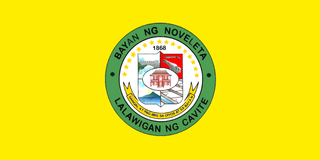
Noveleta, officially the Municipality of Noveleta, formerly known as Tierra Alta during the Spanish colonial era, is a 3rd class municipality in the province of Cavite, Philippines. According to the 2020 census, it has a population of 49,452 people.

San Fernando, officially the City of San Fernando, is a 1st class component city and capital of the province of Pampanga, Philippines. According to the 2020 census, it has a population of 354,666 people.
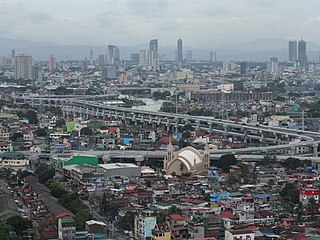
Pandacan is a district in Manila, Philippines which is known in recent history for its former Pandacan oil depot which supplies the majority of oil exports in the country.

Juan Felipe de Jesús Nakpil, KGCR, KSS known as Juan Nakpil, was a Filipino architect, teacher and a community leader. In 1973, he was named one of the National Artists for architecture. He was regarded as the Dean of Filipino Architects.
Beer in the Philippines is mainly produced by two large breweries, San Miguel Corporation, which produces San Miguel Pale Pilsen, and Asia Brewery, the country's second-largest brewery. In addition, there are a number of microbreweries across the nation.

Newport World Resorts is an integrated resort, located in Newport City, opposite Ninoy Aquino International Airport (NAIA) Terminal 3, in Pasay, Metro Manila, Philippines. The resort is owned and operated by Travellers International Hotel Group, Inc. (TIHGI), a joint venture between Alliance Global Group and Genting Hong Kong. The project, occupying part of a former military camp, has four hotels, casino gambling areas, a shopping mall, cinemas, restaurants, clubs and a theater. A soft launch of the resort took place on August 28, 2009. Resorts World Manila is the sister resort to Resorts World Genting in Malaysia and Resorts World Sentosa in Singapore. It was the first integrated resort in Metro Manila, and from 2009 to 2013 it was the only one in operation until the opening of Solaire Resort & Casino in Entertainment City, Parañaque on March 16, 2013.
Andrés Soriano Sr. was a Spanish Filipino industrialist. Described by The New York Times in 1964 as "one of the most dominant business personalities in the western Pacific area," he was best known for expanding the original San Miguel Brewery evolving into San Miguel Corporation.

Ancestral houses of the Philippines or Heritage Houses are homes owned and preserved by the same family for several generations as part of the Filipino family culture. It corresponds to long tradition by Filipino people of giving reverence for ancestors and elders. Houses could be a simple house to a mansion. The most common ones are the "Bahay na Bato". Some houses of prominent families had become points of interest or museums in their community because of its cultural, architectural or historical significance. These houses that are deemed of significant importance to the Filipino culture are declared Heritage House by the National Historical Commission of the Philippines (NHCP), previously known as the National Historical Institute (NHI) of the Philippines. Preservation is of utmost importance as some ancestral houses have come into danger due to business people who buy old houses in the provinces, dismantle them then sell the parts as ancestral building materials for homeowners wishing to have the ancestral ambiance on their houses. These ancestral houses provide the current generation a look back of the country's colonial past through these old houses.

In Metro Manila, Philippines, tourism is a significant industry in the metropolitan region. In 2012, the city and the region welcomed 974,379 overnight visitors. Serving as the main gateway to the Philippines' numerous destinations, the city attracts mainly international tourists, with a total of 3,139,756 visitors in 2012. Global Blue ranks Manila as the eleventh 'Best Shopping Destination' in Asia. The city holds the tenth position in MasterCard's global top 20 fastest-growing cities for international visitors from 2009 to 2013.

Paciano Rizal is an urban barangay comprising in Calamba, Laguna, in the Philippines. It is the fifth most important barangay in Calamba City. It is situated to the west of San Cristobal, to the east of Mayapa, to the north of Lawa and south of Mapagong. The barangay Paciano Rizal of Calamba named by the people of Paciano Rizal an older brother of José Rizal. Paciano Rizal was born in this barangay.

Kapitan Moy Building, also known as Cultural Center of Marikina situated in Marikina, Metro Manila, the Philippines, is the 200-year-old house of Don Laureano Guevarra, known as the founder of the Marikina shoe industry. Also known as Kapitan Moy, he served as capitan municipal in the former municipality. A historical marker honoring him as the "Pioneer of the Shoe-making Industry in Marikina" was installed at his birthplace in 1970. Presently, there are two restaurants found in the ground floor of the Kapitan Moy Building and these are Café Kapitan Restaurant and Kusina ni Kambal. At the Café Kapitan Restaurant is an old well which serves as a décor and a wishing well to customers.
The first full-time mechanical sawmill in the Philippines, the Ascerradura de Mecanica, was opened in the 1880s by Tuason and Sampedro in Gunao Street in Quiapo, a heavily mestizo section of Manila.
This is a list of historic houses in Santa Ana, Manila, the Philippines.

The Rafael Enriquez House, also known as Casa Hidalgo, is a heritage house originally located at Quiapo, Manila, owned by Rafael Enriquez, a Spanish peninsular and painter (1850–1937). The house was built in 1867 – one of the first projects of architect Felix Roxas y Arroyo. Some of his notable works were Paterno House and Zamora House in Quiapo, Manila and the 1867 Santo Domingo Church in Intramuros, Manila. However, a carving on king post, stating "1807", indicates that the house was built before Rafael Enriquez occupied the house. This was discovered in 2006 – wherein the house was dismantled and relocated at Las Casas Filipinas de Acuzar, Bagac, Bataan.
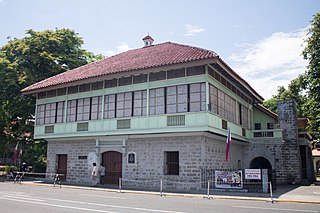
Bahay na bato, also known in Cebuano as balay na bato or balay nga bato and in Spanish as casa Filipino, is a type of building originating during the Spanish colonial period of the Philippines. It is an updated version of the traditional bahay kubo of the Christianized lowlanders, known for its use of masonry in its construction, using stone and brick materials and later synthetic concrete, rather than just full organic materials of the former style. Its design has evolved throughout the ages, but still maintains the bahay kubo's architectural principle, which is adapted to the tropical climate, stormy season, and earthquake-prone environment of the whole archipelago of the Philippines, and fuses it with the influence of Spanish colonizers and Chinese traders. It is one of the many architecture throughout the Spanish Empire known as Arquitectura mestiza. The style is a hybrid of Austronesian, Spanish, and Chinese; and later, with early 20th-century American architecture, supporting the fact that the Philippines is a result of these cultures mixing. Its most common appearance features an elevated, overhanging wooden upper story standing on wooden posts in a rectangular arrangement as a foundation. The posts are placed behind Spanish-style solid stone blocks or bricks, giving the impression of a first floor. Still, the ground level contains storage rooms, cellars, shops, or other business-related functions. The second floor is the elevated residential apartment, as it is with the bahay kubo. The roof materials are either tiled or thatched with nipa, sago palm, or cogon, with later 19th-century designs featuring galvanization. Roof styles are traditionally high pitched and are include the gable roof, hip roof, East Asian hip roof, and the simpler East Asian hip-and-gable roof. Horses for carriages are housed in stables called caballerizas.

Tambo is an administrative division in southern Metro Manila, the Philippines. It is a coastal barangay in the city of Parañaque situated just south of Baclaran adjoining Ninoy Aquino International Airport complex to the east.















